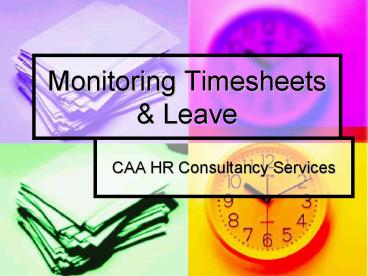Monitoring Timesheets - PowerPoint PPT Presentation
1 / 15
Title:
Monitoring Timesheets
Description:
Maximum of 9 ordinary hours in a day; ... time of commencement of duty in the morning; the cessation of duty for lunch; re-commencement after lunch; cessation ... – PowerPoint PPT presentation
Number of Views:65
Avg rating:3.0/5.0
Title: Monitoring Timesheets
1
Monitoring Timesheets Leave
- CAA HR Consultancy Services
2
Supervisors Responsibilities
- It is the supervisors responsibility to
- Check that their staff are accurately recording
their working hours, including meal breaks and - Ensure that their staff correctly submit leave
requests for absences on sick, recreational, long
service or other leave.
3
Working hours parameters
- SLQs Working Hours Arrangements Policy (HR1)
allows - Spread of hours 7am to 6pm at all SLQ locations
for a trial period of 6 months from December
2003 - Maximum of 9½ ordinary hours in a day
- Compulsory meal break (at least 30 minutes) after
5½ hours - Full copy of the Policy is available on SLQnet.
4
What do staff need to record?
- In relation to each working day, staff must
record - the time of commencement of duty in the morning
- the cessation of duty for lunch
- re-commencement after lunch
- cessation of duty for the day and
- any absences during the day for purposes of
leave. - Time recorded to nearest 5 minutes.
5
What if there is a problem with staff accurately
recording their working hours?
- The Policy states
- First stepverbal warning
- Second stepwritten warning
- Third stepif State Librarian is satisfied of
non-compliance, instruction to work standard
hours for 4 weeks - If it continueslonger standard hours or
disciplinary action. - Standard Hours are 7¼ hours worked from 9am to
5pm with a 45 minute lunch break from 1 to 1.45pm.
6
What evidence do I need to have before I act?
- Evidence is based on the balance of
probabilities. - If you have a reasonable suspicion that an
employee has incorrectly recorded an entry on
their timesheets, then that is enough to prompt
initial. discussion with the employee.
7
But I only see my staffs timesheets every
fortnight
- If you are concerned by
- an employees comings or goings and
- about whether they are recording times correctly
- it is OK to note a time on a particular day in
your diary to cross check at the end of the
recording cycle.
8
Step one verbal warning
- All employees have a right to respond to your
concerns about their time recording, so - Clearly explain your concern and
- Give the employee an opportunity to respond.
- You need to do this before you issue the verbal
warning. If the reason is not satisfactory, then
warn the employee and make a file note.
9
Step two written warning
- Same process as step one.
- A written warning must be clear and concise and
issued only after due process is followed (i.e.
allowing an employee to respond to your
concerns). - If you are unsure on how to draft a written
warning, you should consult with a HR consultant
at the CAA.
10
Step three standard hours
- If an employee fails to adhere to the written
warning, you need to - Write a brief report to the State Librarian (via
your Director) requesting that the employee be
instructed to work standard hours. - The report must outline how you have complied
with the first two steps.
11
Step four longer standard hours or disciplinary
action
- If you need to consider this option you should
discuss it with a HR Consultant at the CAA and
your Director.
12
Monitoring Leave
- Whilst it is an employees responsibility to
submit leave forms this does not always happen. - It is a responsibility of supervisors to ensure
that leave forms are submitted for all leave
taken.
13
How do I monitor my staffs leave?
- There are no set ways to do this, but you can
- Track forms through either the tasks option in
Outlook on your computer or - In a diary or
- In a notebook.
14
When should I chase up leave forms?
- For scheduled leave (e.g. Rec or Long Service
Leave), before the leave commences and - For unscheduled leave (e.g. sick leave), at the
end of a timesheet cycle if not previously
submitted.
15
Further Information
- CAA HR Consultancy Services
- Paul Davey 3842 9174
- Michael Rudd 3842 9341
- Payroll
- Melissa Dowling 3842 9363































